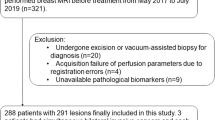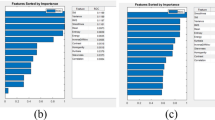Abstract
Objectives
To determine whether texture analysis for magnetic resonance imaging (MRI) can predict recurrence in patients with breast cancer treated with neoadjuvant chemotherapy (NAC).
Methods
This retrospective study included 130 women who received NAC and underwent subsequent surgery for breast cancer between January 2012 and August 2017. We assessed common features, including standard morphologic MRI features and clinicopathologic features. We used a commercial software and analyzed texture features from pretreatment and midtreatment MRI. A random forest (RF) method was performed to build a model for predicting recurrence. The diagnostic performance of this model for predicting recurrence was assessed and compared with those of five other machine learning classifiers using the Wald test.
Results
Of the 130 women, 21 (16.2%) developed recurrence at a median follow-up of 35.4 months. The RF classifier with common features including clinicopathologic and morphologic MRI features showed the lowest diagnostic performance (area under the receiver operating characteristic curve [AUC], 0.83). The texture analysis with the RF method showed the highest diagnostic performances for pretreatment T2-weighted images and midtreatment DWI and ADC maps showed better diagnostic performance than that of an analysis of common features (AUC, 0.94 vs. 0.83, p < 0.05). The RF model based on all sequences showed a better diagnostic performance for predicting recurrence than did the five other machine learning classifiers.
Conclusions
Texture analysis using an RF model for pretreatment and midtreatment MRI may provide valuable prognostic information for predicting recurrence in patients with breast cancer treated with NAC and surgery.
Key Points
• RF model-based texture analysis showed a superior diagnostic performance than traditional MRI and clinicopathologic features (AUC, 0.94 vs.0.83, p < 0.05) for predicting recurrence in breast cancer after NAC.
• Texture analysis using RF classifier showed the highest diagnostic performances (AUC, 0.94) for pretreatment T2-weighted images and midtreatment DWI and ADC maps.
• RF model showed a better diagnostic performance for predicting recurrence than did the five other machine learning classifiers.




Similar content being viewed by others
Abbreviations
- ADC:
-
Apparent diffusion coefficient
- AUC:
-
Area under the receiver operating characteristic curve
- CI:
-
Confidence interval
- DWI:
-
Diffusion-weighted imaging
- HER2:
-
Human epidermal growth factor receptor 2
- HR:
-
Hazard ratio
- MRI:
-
Magnetic resonance imaging
- NAC:
-
Neoadjuvant chemotherapy
- RF:
-
Random forest
- ROI:
-
Region of interest
References
Kaufmann M, von Minckwitz G, Bear HD et al (2007) Recommendations from an international expert panel on the use of neoadjuvant (primary) systemic treatment of operable breast cancer: new perspectives 2006. Ann Oncol 18:1927–1934
Gralow JR, Burstein HJ, Wood W et al (2008) Preoperative therapy in invasive breast cancer: pathologic assessment and systemic therapy issues in operable disease. J Clin Oncol 26:814–819
Cortazar P, Zhang L, Untch M et al (2014) Pathological complete response and long-term clinical benefit in breast cancer: the CTNeoBC pooled analysis. Lancet 384:164–172
Hylton NM, Gatsonis CA, Rosen MA et al (2016) Neoadjuvant chemotherapy for breast cancer: functional tumor volume by MR imaging predicts recurrence-free survival-results from the ACRIN 6657/CALGB 150007 I-SPY 1 TRIAL. Radiology 279:44–55
Rouzier R, Extra JM, Carton M et al (2001) Primary chemotherapy for operable breast cancer: incidence and prognostic significance of ipsilateral breast tumor recurrence after breast-conserving surgery. J Clin Oncol 19:3828–3835
Chen AM, Meric-Bernstam F, Hunt KK et al (2004) Breast conservation after neoadjuvant chemotherapy: the MD Anderson cancer center experience. J Clin Oncol 22:2303–2312
Meyers MO, Klauber-Demore N, Ollila DW et al (2011) Impact of breast cancer molecular subtypes on locoregional recurrence in patients treated with neoadjuvant chemotherapy for locally advanced breast cancer. Ann Surg Oncol 18:2851–2857
Shin SU, Cho N, Lee HB et al (2018) Neoadjuvant chemotherapy and surgery for breast cancer: preoperative MRI features associated with local recurrence. Radiology 289:30–38
Gillies RJ, Kinahan PE, Hricak H (2016) Radiomics: images are more than pictures, they are data. Radiology 278:563–577
Gibbs P, Turnbull LW (2003) Textural analysis of contrast-enhanced MR images of the breast. Magn Reson Med 50:92–98
Waugh SA, Purdie CA, Jordan LB et al (2016) Magnetic resonance imaging texture analysis classification of primary breast cancer. Eur Radiol 26:322–330
Parikh J, Selmi M, Charles-Edwards G et al (2014) Changes in primary breast cancer heterogeneity may augment midtreatment MR imaging assessment of response to neoadjuvant chemotherapy. Radiology 272:100–112
Kim JH, Ko ES, Lim Y et al (2017) Breast cancer heterogeneity: MR imaging texture analysis and survival outcomes. Radiology 282:665–675
Park H, Lim Y, Ko ES et al (2018) Radiomics signature on magnetic resonance imaging: association with disease-free survival in patients with invasive breast cancer. Clin Cancer Res 24:4705–4714
Fan M, Xia P, Liu B et al (2019) Tumour heterogeneity revealed by unsupervised decomposition of dynamic contrast-enhanced magnetic resonance imaging is associated with underlying gene expression patterns and poor survival in breast cancer patients. Breast Cancer Res 21:112
Lee J, Kim SH, Kang BJ (2020) Prognostic factors of disease recurrence in breast cancer using quantitative and qualitative magnetic resonance imaging (MRI) Parameters. Sci Rep 10:7598
Chitalia RD, Rowland J, McDonald ES et al (2020) Imaging phenotypes of breast cancer heterogeneity in preoperative breast dynamic contrast enhanced magnetic resonance imaging (DCE-MRI) scans predict 10-year recurrence. Clin Cancer Res 26:862–869
Eun NL, Kang D, Son EJ et al (2020) Texture analysis with 3.0-T MRI for association of response to neoadjuvant chemotherapy in breast cancer. Radiology 294:31–41
Davnall F, Yip CS, Ljungqvist G et al (2012) Assessment of tumor heterogeneity: an emerging imaging tool for clinical practice? Insights Imaging 3:573–589
Pickles MD, Lowry M, Gibbs P (2016) Pretreatment prognostic value of dynamic contrast-enhanced magnetic resonance imaging vascular, texture, shape, and size parameters compared with traditional survival indicators obtained from locally advanced breast cancer patients. Invest Radiol 51:177–185
Wu J, Cao G, Sun X et al (2018) Intratumoral Spatial Heterogeneity at Perfusion MR Imaging Predicts Recurrence-free Survival in Locally Advanced Breast Cancer Treated with Neoadjuvant Chemotherapy. Radiology 288:26–35
Yoon HJ, Kim Y, Chung J et al (2019) Predicting neo-adjuvant chemotherapy response and progression-free survival of locally advanced breast cancer using textural features of intratumoral heterogeneity on F-18 FDG PET/CT and diffusion-weighted MR imaging. Breast J 25:373–380
Uematsu T (2015) Focal breast edema associated with malignancy on T2-weighted images of breast MRI: peritumoral edema, prepectoral edema, and subcutaneous edema. Breast Cancer 22:66–70
Fukada I, Araki K, Kobayashi K et al (2018) Pattern of tumor shrinkage during neoadjuvant chemotherapy is associated with prognosis in low-grade luminal early breast cancer. Radiology 286:49–57
Breiman L (2001) Random Forests. Mach Learn 45:5–32
Ueno Y, Forghani B, Forghani R et al (2017) Endometrial carcinoma: MR imaging-based texture model for preoperative risk stratification-a preliminary analysis. Radiology 284:748–757
Horvat N, Veeraraghavan H, Khan M et al (2018) MR imaging of rectal cancer: radiomics analysis to assess treatment response after neoadjuvant therapy. Radiology 287:833–843
Mitchell M (2011) Bias of the random forest out-of-bag (OOB) error for certain input parameters. Open J Stat 01:205–211
Chawla NV, Bowyer KW, Hall LO et al (2002) SMOTE: synthetic minority over-sampling technique. J Artif Intell Res 16:321–357
Chen W, Samuelson FW, Gallas BD et al (2013) On the assessment of the added value of new predictive biomarkers. BMC Med Res Methodol 13:98
Pedregosa F, Varoquaux G, Gramfort A et al (2011) Scikit-learn: machine learning in Python. J Mach Learn Res 12:2825–2830
Lemaitre G, Nogueira F, Aridas CK (2016) Imbalanced-learn: a Python toolbox to tackle the curse of imbalanced datasets in machine learning. J Mach Learn Res 18:1–5
Kim JY, Kim JJ, Hwangbo L et al (2020) Kinetic heterogeneity of breast cancer determined using computer-aided diagnosis of preoperative MRI scans: relationship to distant metastasis-free survival. Radiology 295(3):517–526
Tahmassebi A, Wengert GJ, Helbich TH et al (2019) Impact of machine learning with multiparametric magnetic resonance imaging of the breast for early prediction of response to neoadjuvant chemotherapy and survival outcomes in breast cancer patients. Invest Radiol 54:110–117
Kanda T, Fukusato T, Matsuda M et al (2015) Gadolinium-based contrast agent accumulates in the brain even in subjects without severe renal dysfunction: evaluation of autopsy brain specimens with inductively coupled plasma mass spectroscopy. Radiology 276:228–232
Acknowledgements
This study was supported by a faculty research grant from the Yonsei University College of Medicine (grant no. 6-2020-0103).
Funding
The authors state that this work has not received any funding.
Author information
Authors and Affiliations
Corresponding author
Ethics declarations
Guarantor
The scientific guarantor of this publication is Hye Mi Gweon.
Conflict of interest
The authors of this manuscript declare no relationships with any companies whose products or services may be related to the subject matter of the article.
Statistics and biometry
One of the authors has significant statistical expertise.
Informed consent
Written informed consent was waived by the Institutional Review Board.
Ethical approval
Institutional Review Board approval was obtained.
Study subjects or cohorts overlap
One hundred and thirty study subjects overlap with a study published in Radiology in January 2020. Unlike a previous study which showed the association between texture features of breast MRI and treatment response in breast cancer, this study was to investigate the value of texture features of breast MRI for predicting recurrence, compared to standard clinicopathologic and morphologic MRI analysis.
- Eun NL, Kang D, Son EJ, et al (2020) Texture analysis with 3.0-T MRI for association of response to neoadjuvant chemotherapy in breast cancer. Radiology 294:31-41
Methodology
• Retrospective
• Diagnostic or prognostic study
• Performed at one institution
Additional information
Publisher’s note
Springer Nature remains neutral with regard to jurisdictional claims in published maps and institutional affiliations.
Supplementary Information
ESM 1
(DOCX 29 kb)
Rights and permissions
About this article
Cite this article
Eun, N.L., Kang, D., Son, E.J. et al. Texture analysis using machine learning–based 3-T magnetic resonance imaging for predicting recurrence in breast cancer patients treated with neoadjuvant chemotherapy. Eur Radiol 31, 6916–6928 (2021). https://doi.org/10.1007/s00330-021-07816-x
Received:
Revised:
Accepted:
Published:
Issue Date:
DOI: https://doi.org/10.1007/s00330-021-07816-x




